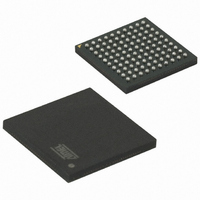AT91SAM7XC512-CU Atmel, AT91SAM7XC512-CU Datasheet - Page 556

AT91SAM7XC512-CU
Manufacturer Part Number
AT91SAM7XC512-CU
Description
MCU ARM 512K HS FLASH 100-TFBGA
Manufacturer
Atmel
Series
AT91SAMr
Specifications of AT91SAM7XC512-CU
Core Processor
ARM7
Core Size
16/32-Bit
Speed
55MHz
Connectivity
CAN, Ethernet, I²C, SPI, SSC, UART/USART, USB
Peripherals
Brown-out Detect/Reset, DMA, POR, PWM, WDT
Number Of I /o
62
Program Memory Size
512KB (512K x 8)
Program Memory Type
FLASH
Ram Size
128K x 8
Voltage - Supply (vcc/vdd)
1.65 V ~ 1.95 V
Data Converters
A/D 8x10b
Oscillator Type
Internal
Operating Temperature
-40°C ~ 85°C
Package / Case
100-TFBGA
Processor Series
AT91SAMx
Core
ARM7TDMI
Data Bus Width
32 bit
Data Ram Size
128 KB
Interface Type
MII, SPI, TWI
Maximum Clock Frequency
55 MHz
Number Of Programmable I/os
62
Number Of Timers
3
Maximum Operating Temperature
+ 85 C
Mounting Style
SMD/SMT
3rd Party Development Tools
JTRACE-ARM-2M, KSK-AT91SAM7X-PL, MDK-ARM, RL-ARM, ULINK2
Development Tools By Supplier
AT91SAM-ICE, AT91-ISP, AT91SAM7XC-EK
Minimum Operating Temperature
- 40 C
On-chip Adc
10 bit, 8 Channel
For Use With
AT91SAM-ICE - EMULATOR FOR AT91 ARM7/ARM9AT91SAM7XC-EK - KIT EVAL FOR AT91SAM7XC256/128
Lead Free Status / RoHS Status
Lead free / RoHS Compliant
Eeprom Size
-
Lead Free Status / Rohs Status
Lead free / RoHS Compliant
Available stocks
Company
Part Number
Manufacturer
Quantity
Price
- Current page: 556 of 727
- Download datasheet (11Mb)
38.6.4
38.6.4.1
6209F–ATARM–17-Feb-09
CAN 2.0 Standard Features
CAN Bit Timing Configuration
All controllers on a CAN bus must have the same bit rate and bit length. At different clock fre-
quencies of the individual controllers, the bit rate has to be adjusted by the time segments.
The CAN protocol specification partitions the nominal bit time into four different segments:
Figure 38-4. Partition of the CAN Bit Time
The TIME QUANTUM (TQ) is a fixed unit of time derived from the MCK period. The total number
of TIME QUANTA in a bit time is programmable from 8 to 25.
SYNC SEG: SYNChronization Segment.
This part of the bit time is used to synchronize the various nodes on the bus. An edge is
expected to lie within this segment. It is 1 TQ long.
This part of the bit time is used to compensate for the physical delay times within the network. It
is twice the sum of the signal’s propagation time on the bus line, the input comparator delay, and
the output driver delay. It is programmable to be 1,2,..., 8 TQ long.
This parameter is defined in the PROPAG field of the
The Phase-Buffer-Segments are used to compensate for edge phase errors. These segments
can be lengthened (PHASE SEG1) or shortened (PHASE SEG2) by resynchronization.
Phase Segment 1 is programmable to be 1,2,..., 8 TQ long.
Phase Segment 2 length has to be at least as long as the Information Processing Time (IPT)
and may not be more than the length of Phase Segment 1.
These parameters are defined in the PHASE1 and PHASE2 fields of the
Register”.
The Information Processing Time (IPT) is the time required for the logic to determine the bit level
of a sampled bit. The IPT begins at the sample point, is measured in TQ and is fixed at 2 TQ for
the Atmel CAN. Since Phase Segment 2 also begins at the sample point and is the last seg-
ment in the bit time, PHASE SEG2 shall not be less than the IPT.
• TIME QUANTUM
• PROP SEG: PROPagation Segment.
• PHASE SEG1, PHASE SEG2: PHASE Segment 1 and 2.
• INFORMATION PROCESSING TIME:
• SAMPLE POINT:
SYNC_SEG
AT91SAM7XC512/256/128 Preliminary
PROP_SEG
NOMINAL BIT TIME
PHASE_SEG1
”CAN Baudrate
Sample Point
PHASE_SEG2
Register”.
”CAN Baudrate
556
Related parts for AT91SAM7XC512-CU
Image
Part Number
Description
Manufacturer
Datasheet
Request
R

Part Number:
Description:
KIT EVAL FOR AT91SAM7XC256/128
Manufacturer:
Atmel
Datasheet:

Part Number:
Description:
KIT EVAL FOR AT91SAM7X256/128
Manufacturer:
Atmel
Datasheet:

Part Number:
Description:
MCU, MPU & DSP Development Tools KICKSTART KIT ATMEL AT91SAM7X
Manufacturer:
IAR Systems

Part Number:
Description:
MCU ARM9 64K SRAM 144-LFBGA
Manufacturer:
Atmel
Datasheet:

Part Number:
Description:
IC ARM7 MCU FLASH 256K 100LQFP
Manufacturer:
Atmel
Datasheet:

Part Number:
Description:
IC ARM9 MPU 217-LFBGA
Manufacturer:
Atmel
Datasheet:

Part Number:
Description:
MCU ARM9 ULTRA LOW PWR 217-LFBGA
Manufacturer:
Atmel
Datasheet:

Part Number:
Description:
MCU ARM9 324-TFBGA
Manufacturer:
Atmel
Datasheet:

Part Number:
Description:
IC MCU ARM9 SAMPLING 217CBGA
Manufacturer:
Atmel
Datasheet:

Part Number:
Description:
IC ARM9 MCU 217-LFBGA
Manufacturer:
Atmel
Datasheet:

Part Number:
Description:
IC ARM9 MCU 208-PQFP
Manufacturer:
Atmel
Datasheet:

Part Number:
Description:
MCU ARM 512K HS FLASH 100-LQFP
Manufacturer:
Atmel
Datasheet:

Part Number:
Description:
MCU ARM 512K HS FLASH 100-TFBGA
Manufacturer:
Atmel
Datasheet:

Part Number:
Description:
IC ARM9 MCU 200 MHZ 324-TFBGA
Manufacturer:
Atmel
Datasheet:

Part Number:
Description:
IC ARM MCU 16BIT 128K 256BGA
Manufacturer:
Atmel
Datasheet:











